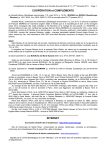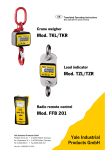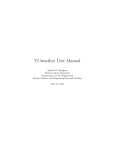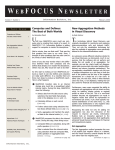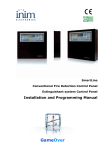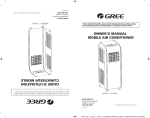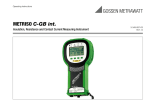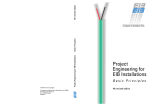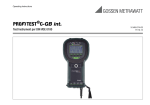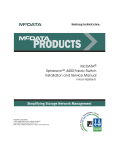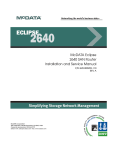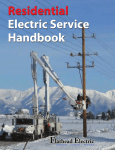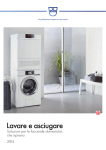Download Guideline on Managing Safety in the Use of Portable
Transcript
Guideline on Managing Safety in the Use of Portable Electrical Equipment in the Workplace Section for Electricity Guideline on Managing Safety in the Use of Portable Electrical Equipment in the Workplace April 2009 The ISSA Electricity Section would like to thank all members of the international working group for their effort and commitment in the development of the guideline. Eamon O’Flynn, Electricity Supply Board, Ireland – Convenor Burkhard Schulze, ZVEH, Germany Hartmut Oelmann, BG ETE, Germany Heiner Kehne, Siemens, Germany Jens Jühling, ISSA, Electricity Section, Germany Joydeep Mukherjee, ISSA, Electricity Section, Germany Josef Fornusek, CSZE, Czech Republic Jost Keller, Electrosuisse, Switzerland, Lothar Kinzig, ABB, Germany Mihai Budan, Transelectrica, Romania Raúl Arenas García, Endesa, Spain Segundo Caeiro Ríos, Endesa, Spain Ted Vandevis, EU&SA, Canada Wolfgang Pechoc, BG ETE, Germany Zdenek Václavek, CSZE, Czech Republic ISBN-Nr. 978-3-937824-02-4 Editor: International Social Security Association Section for Electricity, Gas and Water c/o Berufsgenossenschaft Energie Textil Elektro Gustav-Heinemann-Ufer 130, D-50968 Köln All rights reserved. No part of this book may be reprinted or reproduced or utilzed in any form or by any electronic, mechanical, or other means, now known or hereafter invented, including photocopying and recording, or in any information storage or retrieval system, without permission in writing from the publishers. Contents Page Foreword 5 11. Introduction 6 12. Scope 8 13. Definitions 10 14. Who is this Guideline aimed at? 12 15. Relevant Legislation / Codes of Practice 13 16. Guidance on Safety Standards associated with the Selection of Portable Electrical Equipment 14 17. Electrical Installation Safety Features for Portable Electrical Equipment 16 18. Safe use and Care of Portable Electrical Equipment 18 19. Inspection of Portable Electrical Equipment by the User 19 10. Periodic inspection of Portable Electrical Equipment by a competent person 21 11. Periodic Testing of Portable Electrical Equipment by a competent person 23 12. Elements of a Periodic Inspection and Test System 26 3 Contents Page Appendices and Recommended Source Documents Appendix 1: International Technical Standards / National Legislation and Codes of Practice for Individual Countries 28 Appendix 2: Examples of Periodic Test and Inspection Schedules 36 Appendix 3: Examples of Inspection and Test Record Forms 39 Appendix 4: 42 Technical Standards for carrying out / Tests on Portable Electrical Equipment Appendix 5: Safety Marks / Identifiers associated with Portable Electrical Equipment 43 Recommended Source Documents 47 4 Foreword This Guideline describes safe practices that should be followed by those involved with portable electrical equipment. The Guideline is not designed as a training manual, but contains information, best practices and general recommendations deemed appropriate for the safe use of portable electrical equipment. The approach contained in the guideline reflects a recommended minimum standard. Note: The contents of the Guideline, including all advice, recommendations and procedures, are provided as a service by the ISSA Electricity Section and are intended for informational purposes only. No representation of any kind is made to any person, business or entity whatsoever with regard to the accuracy, completeness or sufficiency of the information contained herein. Any and all use of or reliance upon this Guideline and the information contained herein is solely and entirely at the user’s risk. The ISSA Electricity Section shall not be in any way responsible or liable for any form of loss or damage incurred as a result of any form or manner of reliance upon any part or portion of this Guideline. 5 1. Introduction The use of portable electrical equipment is a common requirement in the workplace. Such equipment ranges from desk-lamps in offices to drills and grinders on construction sites. All of these devices are potential safety hazards and therefore controls and safeguards need to be put in place to deal with the associated risks. The degree of maintenance, and this includes inspection and test, varies from country to country in line with national legislation and codes of practice. In general, there is a requirement for employers to take the necessary steps that will minimise risk to employees, in so far as it is reasonably practicable. It would appear that in the majority of countries, systematic inspection and test of equipment by competent persons does not take place. However, in some countries the practice of periodic inspection and test has been instituted. The frequency of periodic inspections and tests can vary between weekly and 4 years. The frequency is determined by the associated risk e. g. whether the equipment is office-based; or in use on a construction site; what protection does the electrical installation provide; and also on the level of defects found as a result of carrying out the process of inspection and test. The purpose of this guideline is to promote a best practice approach to the maintenance of portable electrical equipment. It contains common elements from individual national practices that are considered to be best practice. Examples of national legislation / codes of practice of participating countries are included in the Appendices. Note on Accident Statistics: Accident statistics covering electrical aspects of Portable Electrical Equipment are inconsistent from country to country due to variations in the methods of compilation. Portable equipment is defined in different ways, and in any event the vast majority of associated accidents are non-electrical. Where electrical accidents are reported, they may not be due to defective equipment. It is therefore difficult to come to any firm conclusions. 6 1. Introduction An examination of available information shows that the ratio of portable electrical equipment accidents to all electrical accidents is approximately 1:5 (source: Germany). We also know that if there is a risk due to electricity, the risk of fatality is significantly greater. A typical fatality: injury ratio for all accidents can be in the order of 1:160, but this rises to 1:14, where electricity is the cause of the accident (source: Canada). Furthermore, this Guideline includes the maintenance of hand-held tools. The greatest risk of electrical shock applies when there is a likelihood of current flowing from hand to hand. Hand-held equipment presents a particular danger in this regard. It is therefore essential that all possible steps be taken to reduce any risk associated with Portable Electrical Equipment. It is hoped that this Guideline will contribute towards a safer working environment for users of Portable Electrical Equipment. 7 2. Scope The focus of the guideline is directed at low voltage AC (110 to 230 V) equipment which is commonly used in the workplace. In particular it refers to portable equipment. Throughout this guide the term ‘portable electrical equipment’ is used to describe electrical devices that are not part of a fixed electrical installation, but are intended to be connected to a fixed installation or generator by means of a flexible cable and socket-outlet. Typical examples are portable, hand operated and movable plug-in electrical appliances used at a workplace. The equipment covered in this Guideline is defined in IEV 60050-826 as being “Handheld” or “Mobile”. Handheld: This is defined as equipment that is “intended to be held in the hand during normal use”. Mobile: This is defined as equipment that is “moved while in operation, or which can easily be moved from one place to another while connected to the supply”. This Guideline applies to portable equipment having a mass not exceeding 18 kgs, and connection to the electrical supply is assumed to be via plug and socket-outlet. Examples of portable equipment: • • • • • • • • • • 8 Hand drills Hand saws Paint sprayers Soldering irons Vacuum cleaners Grinders Desk lamps Heaters Fans Flexible Cables / Extension Leads 2. Scope The guideline deals with safe practices which will ensure that such devices are electrically safe. Such practices will encompass safety features in the type of electrical installation which supplies the portable equipment. However, it will principally deal with routine maintenance and this includes inspection and test of equipment. The guideline contains a best practice approach to inspection and test. It also covers the identification and tagging of equipment to ensure that adequate records exist of test and inspection. A risk assessment will assist in deciding on the degree of inspection and test. The degree of inspection and test will vary depending on whether the equipment is used in a hostile operating environment, or used in an office building, a classroom, etc. The quality of the equipment is of paramount importance in the first instance. Some guidance on recognising good quality equipment is also included. 9 3. Definitions (IEC-Definitions are used where available) Competent person A person possessing adequate qualifications, such as suitable training and sufficient knowledge, experience and skill for the safe performance of the specific work. A competent person must be approved to carry out any work undertaken. Hostile operating environment Includes an operating environment that may cause mechanical damage to the item of equipment or expose the equipment to moisture, heat, vibration, corrosive substances or dust. Inspection Examination of electrical equipment using all the senses in order to ascertain correct selection and proper erection of electrical equipment. Maintenance Combination of all technical and administrative actions including supervision actions intended to retain an item in, or restore it to a state in which it can perform a required function. Portable equipment According to IEV 60050-826, this is equipment that is either “Handheld” or “Mobile”. Handheld (hand-held equipment 826-16-05): This is defined as equipment that is “intended to be held in the hand during normal use”. Mobile (mobile equipment 826-16-04): This is defined as equipment that is “moved while in operation, or which can easily be moved from one place to another while connected to the supply”. This Guideline applies to portable equipment having a mass not exceeding 18 kgs. (Connection of equipment to the power supply is assumed to be via a plug and socket-outlet.) 10 3. Definitions Reporting Recording of the results of inspection and testing. Testing Implementation of measures on electrical equipment by means of which its effectiveness is proved. NOTE: It includes ascertaining values by means of appropriate measuring instruments, said values not being detectable by inspection. Verification All measures by means of which compliance of the electrical equipment with the relevant requirements of technical standards and those of manufacturers. NOTE: It comprises inspection, testing and reporting. Workplace Any place where a worker is required to carry out work. 11 4. Who is the Guideline aimed at? It is aimed at all employers who are responsible for workplaces where portable electrical equipment is used. Employers are responsible under law for the safety of their employees. They should therefore take all reasonable care that their employees work in a safe environment and use safe equipment. The following questions will help to evaluate if a company is effectively managing electrical safety in the workplace: • Does the Company have a Health and Safety Management System in place? • Does it have a Safety Policy, has it identified hazards and carried out risk assessments? • Does it set safety targets, measure its performance and engage in continuous improvement? • Does it communicate regularly with employees about electrical safety issues? • Is the workplace a safe environment? Are the workers competent and are the tools safe? It is the last point that this Guideline specifically addresses. Where identified by a risk assessment, the employer is responsible for the design and implementation of an effective and safe system of inspection and test. The design and implementation of this system should be carried out by someone having knowledge and experience of this particular subject. This additionally applies to equipment used by contractors and to the use of hired equipment. The purpose of this document is to give employers guidance in the development of Company policy in regard to the safe use of their portable electrical equipment. The content of the Guideline is also intended to be understood by non-technical management. 12 5. Relevant Legislation / Codes of Practice There exists a wide range of publications which have relevance to this topic; Directives, International Technical Standards, National Legislation and Codes of Practice. Subject matter relevant to the safety of portable electrical equipment includes: • Standard of Electrical Installations • Compliance of the Equipment with Safety Symbols / Identifiers, at time of purchase • How the equipment is used and where • How is it maintained, including inspection and testing Appendix 1 includes examples of National Legislation and Codes of Practice. The List of Recommended Source Documents at the end of this Guideline includes relevant Directives and International Technical Standards. In the course of developing this Guideline reference has been made to these documents. 13 6. Guidance on Safety Standards 6. associated with the Selection of 6. Portable Electrical Equipment When purchasing portable electrical equipment always make sure it complies with the compulsory requirements contained in national legislation and relevant Directives. Such regulations require manufacturers, importers, product suppliers, etc. to deliver only safe products to the marketplace. Also, these products should be delivered with instructions on their safe use. Examples of Safety Marks / Identifiers: Reputable certification of adequate safety in equipment purchased can be identified via the above mentioned Marks / Identifiers. The association of these Marks / Identifiers with portable equipment in the marketplace indicates a level of safety which has been verified by an independent agency. This means that a purchaser does not have to rely on the claims of a manufacturer / supplier. Purchasers of equipment need to be aware of possible unauthorised use of these symbols. It is important to distinguish between Quality Marks / Identifiers and those relating to the Safety features of the equipment. This Guideline is principally concerned with Safety. 14 6. Guidance on Safety Standards associated with the Selection of Portable Electrical Equipment Further information on the above mentioned and other Marks / Identifiers is contained in Appendix 5. There are also other requirements which the customer may wish to specify in relation to portable equipment – in addition to the above mentioned: • Easy to use (ergonomic features, size etc.) • Adequate Instructions in the language of the country in which the equipment is sold • Technical support and training included in the manufacturer’s tender • Level of Maintenance / Reliability • Warranty period • Has the manufacturer implemented a certified quality management system (e. g. ISO 9001) • Warning devices, control indications and markings which are essential to the safety of users must be present and easily understood A further consideration in selecting portable electrical equipment is whether an equivalent battery-operated version is available. Where this applies, a dramatic reduction in risk results to the user and the need for safety controls as outlined in this guideline is significantly reduced. 15 7. Electrical Installation Safety Features 7. for Portable Electrical Equipment The safety features of electrical installations are of prime importance. These are designed to protect the users of portable equipment. Compliance with Technical Standard IEC 60364, or equivalent, will ensure that the installation is of the highest standard. Use of the following equipment will reduce the risk to users using portable electrical equipment: 7.1 In general the installation of Residual Current (Protective) Devices (RCDs) [Canada: GFCI: Ground Fault Circuit Interrupters] provides protection to users of portable equipment. When an electrical device is operating safely, the amount of current going to the device equals that leaving. The RCD compares these currents. If there is a difference between these currents (e. g. a leakage from the circuit), a dangerous situation arises for the equipment user, and the RCD switches off the current flow immediately, thus protecting the user. These RCDs should trip in 0.4 sec or less, on leakage currents not exceeding 30 mA and provide the necessary protection to prevent danger to the user from life threatening electric shock. However, the RCD itself needs to be tested periodically as follows: a) Mechanical test: using the dedicated push-button, trip and re-set at frequent intervals. b) It should be electrically tested periodically by a competent person to ensure that it operates at a leakage current of maximum 30 mA in a time of not more than 0.4 sec. 16 7. Electrical Installation Safety Features for Portable Electrical Equipment 7.2 The provision of lower voltage supply equipment to supply portable tools used in areas with increased risk of dangerous shock currents, e. g. construction sites (see IEC 60364-7-704) or conducting locations with restricted movement (see IEC 60364-7-706). Such reduced voltage supply equipment typically consists of a portable step down transformer supplying a nominal 110 V AC output. In some cases the secondary winding is centre-tapped to earth which ensures that the maximum possible shock voltage to earth is approximately 55 V (as used in the UK and in Ireland). 17 8. Safe use and Care of Portable Electrical 8. Equipment As a minimum, the following should apply: • Use it in its intended manner as per manufacturer’s instructions, in its intended environment and never overload it • It should be serviced only by competent personnel, and in accordance with manufacturer’s instructions • Transport it in a secure manner (so as not subject it to unnecessary shocks or vibrations) • Keep the flexible cable away from heat, oil, sharp edges, and moving parts • Assess all risks from the equipment of damage to nearby electrical cables (including supply cables to the equipment), and water pipes • Never use in rain, or in wet conditions (refer to the IP rating) • Only use in explosive atmosphere if rated for such conditions (Refer to the Ex Rating) • When in use, be aware of the following danger signs: • Dim or flickering lights • Arcs / sparks • Sizzling / buzzing sounds • Odours that smell of burning material, e. g. plastic, rubber • Frequent tripping of circuit breakers / fuses • Use correctly rated protective devices and never by-pass these devices • Store it in a careful manner when not in use Where appropriate, users should be instructed in the use and care of equipment, or the relevant instructions concerning the work equipment should be available in a form and language they can understand. 18 9. Inspection of Portable Electrical 9. Equipment by the User Before using any portable electrical equipment, the user should inspect the equipment. The user visually checks that it is safe to use, with no signs of damage or defects, and that it is correctly rated for use in the proposed location and environment. Users should be instructed in the method of carrying out inspections. Check: i Tool / Appliance: Is the on/off switch working correctly? Is there any sign of damage to casing? Are there any loose parts or missing screws? Is there evidence of overheating or moisture? Examine its voltage rating to ensure that it is the right voltage for the purpose (e. g. 110 volt hand tools for construction sites – UK and Ireland) and the appropriate plug-top for that voltage. Are live parts properly guarded, so as not to be inadvertently accessible? ii Flexible Cable and Extension leads: Are they securely anchored to plug and to appliance / tool with no signs of cuts, fraying, brittle cable, leads kinked or coiled, taped joints or overloading (overheating indicated by colour change or smell)? Cable cores should not be externally visible. All cables should be appropriate to the environment in which they are used. iii Plug: Is cable securely anchored, with no signs of cracked casing, overheating, loose or bent pins, or loose strands? Fuses, where fitted, should not show any signs of overheating and be correctly secured. iv Socket-outlet: Is it free from cracks or other damage? Are there any signs of overheating? Is it properly secured? 19 9. Inspection of Portable Electrical Equipment by the User If the ‘user-checks’ indicate that the tool / appliance is faulty or defective or if a fault occurs during subsequent use, the tool / appliance should be taken out of service. It should be marked / tagged as unsafe. It should not be used again until the fault has been identified and repaired and the tool / appliance is tested and certified by a competent person as fit for use. 20 10. Periodic inspection of Portable Electrical 10. Equipment by a competent person This requirement applies to portable electrical equipment that is exposed to conditions likely to cause deterioration liable to result in danger. The requirement to carry out periodic inspections and the frequency of inspection will depend on the outcome of a risk assessment of the hazards associated with the environment in which the equipment is used. For example, in Ireland where 110 V supplies (with earthed centre-tap, 55 V) for portable equipment are a legal requirement on construction sites, such portable equipment would not be subjected to periodic inspection and test by a competent person. See Appendix 2 for examples of Periodic Inspection Schedules. Where the outcome of a risk assessment deems it necessary, a competent person should carry out a ‘user’ inspection as in 9 above, and in addition check the following: i Tool / Appliance: If the appliance is designed to be earthed (Class I) check the integrity of the earth. If it is an appliance which is not earthed (Class 2), check for the symbol. This is a square within a square and may be found on the statutory label. If it is to be used in damp or wet conditions or atmospheres, or in conditions where there is a liability of ingress of dust or solids into its works, has it an appropriate “IP rating”? If it is to be used in potentially explosive atmospheres, has it an appropriate “Ex Rating”? Rated voltage and if appropriate Class category, IP and Ex ratings should be stamped on the appliance or on its rating plate. 21 10. Periodic inspection of Portable Electrical Equipment by a competent person ii Flexible Cable, Extension leads, and plugs: Check that the cable / mains lead is secure at both the tool / appliance and plug and where covers can be removed, that its cores are secure and correctly connected, with no excess insulation removed and with no bare loose strands. Check that fusing is correct, where fitted. The frequency of these inspections should be appropriate to controlling the assessed risks associated with the equipment use. Make a record of such inspections and retain for a suitable period of time. If the inspection by the competent person indicates that the tool / appliance is faulty or defective, the tool / appliance should be taken out of service. It should be marked / tagged as unsafe. It should not be used again until the fault has been identified and repaired and the tool / appliance tested and certified by a competent person as fit for use. Note that these periodic inspections constitute a more rigorous approach (e. g. involve removal of covers) than that carried out by the user. They also play an auditing and back-up role to the user inspections. 22 11. Periodic Testing of Portable Electrical 11. Equipment by a Competent Person The requirement to test and its frequency, will depend on the outcome of a risk assessment of the hazards associated with the environment in which the equipment is used e. g. equipment used in environments where it is safe from accidental damage or environmental degradation, may not need to be tested. Where testing is deemed appropriate, it should be carried out by a competent person. Testing will normally be carried out in conjunction with an inspection as described in Section 10 above. See Appendix 2 for examples of Periodic Test Schedules. Reasons for carrying out testing would include: • As a result of inspections carried out • If required by manufacturer’s instructions • After repairs • After a prolonged period of non-use • Where previous history involves accidents or near misses • Where equipment is second-hand and previous history is unknown • Use of equipment in a hazardous environment: • • Where there maybe a risk of mechanical damage or heavy wear and tear • • Risk of bad weather conditions • • Extremes of temperature / pressure • • Presence of moisture, dust • • Use in explosive atmosphere For example: • A User Inspection may be sufficient where the following applies: • Use in a low risk environment, and • Where Class 2 insulation applies 23 11. Periodic Testing of Portable Electrical Equipment by a Competent Person • Periodic Inspection or Testing may be appropriate where the following applies: • Equipment is 230 V AC and Class 1 • Equipment is used in a hazardous environment • Equipment is handheld: • • Therefore is more likely to become damaged • • There is greater risk of fatal shock to the user Tests carried out should include those listed below – test and tolerance values may need to be sourced from manufacturers: • Polarity Verify the polarity of the supply cables and that connections to the equipment are correct. • Earth continuity (Class 1 equipment) If the electrical safety of equipment is based on a low impedance to earth [those who have a Protective Earth (PE) conductor], then the earth continuity has to be checked. The impedance has to be measured between PE-connection at the powerplug and any metallic part of the equipment which may be hazardous in case of an electrical fault. For protection against electrical shock the PE-impedance should be at about 0.3 Ohm or better. • Insulation resistance Electrical safety depends also on a good insulation resistance between the electrical parts and the touchable and metallic housing. Usually the resistance is measured at a voltage of 250 V or 500 V DC between the internal parts and the metallic parts of the housing. An insulation resistance of 1 Megohm or more is usually good. • Functional Check This is a final check to verify that the equipment is functioning properly. 24 11. Periodic Testing of Portable Electrical Equipment by a Competent Person • Other tests For some equipment it may be recommended by the manufacturer to do some additional tests or inspections. Examples: • noise: grinders, drills, vacuum cleaners • radiation: hand lamps with power LEDs • force: drills • temperature: soldering irons Which additional tests are recommended and how to do these should be found in the user manual. If testing is successful, then: • • • • • Certify the tool / appliance as fit for use Keep a record for a suitable period of time of • test results • name of the inspector and • date on testing If the test is unsuccessful, the tool / appliance should be taken out of service. It should be marked / tagged as unsafe. It should not be used again until the fault has been identified and repaired and the tool / appliance tested and certified by a competent person as fit for use. 25 12. Elements of a Periodic Inspection 12. and Test System A risk assessment will indicate whether a system for the inspection and test of portable electrical equipment will need to be designed and implemented. The elements of such a system should include the following: • • • • • Institute requirement for routine visual checks by the user Development of checklists for formal Inspections Institute system of periodic inspections by competent persons Development of a Work Method for Testing Institute system of testing by competent persons to include tagging of portable electrical equipment Tagging to include identification and “use until date” Tagging to be durable and prominent Bar codes may be used for identification • The system of Inspection and Test to accommodate an outcome where failures occur; appropriate tagging, removal from service etc • Carry out maintenance, repair, and replacement, of tools and equipment, where necessary • Training / instruction of employees in the safe use of the portable electrical equipment where appropriate • Training / instruction of employees to carry out User Inspections • Test instrumentation should be calibrated in compliance with best practice and manufacturers’ instructions • Maintenance of Records • It will be necessary to keep a register of all electrical tools as well as records of all inspections, test and maintenance carried out. In particular, the following information should be recorded: • • Tool Register to include: Make, Model, Serial Number, Year of Purchase, Location, Frequency of Formal Inspection, Frequency of Test 26 12. Elements of a Periodic Inspection and Test System • • Identification of equipment to be inspected or tested (bar code, serial number, etc) • • Records of Periodic Inspections and Tests to include: •– • Name of the person who carried out the inspection, test or maintenance •– • Dates carried out •– • Result or outcome •– • Date when the next inspection and test must be carried out • • Records of Periodic Inspections and Testing should be held for an adequate period of time and at least until the next inspection and test 27 Appendix 1 International Technical Standards / National Legislation and Codes of Practice for Individual Countries Measures to reduce risk for users of Portable Electrical Equipment are covered in a range of publications which includes directives, legislation, international standards, and national codes of practice. The quality of the electrical installation and the associated protection provided, perform a primary role in regard to the safety of users of Portable Electrical Equipment. The following are some examples of requirements and recommendations which impact on the safety of persons using Portable Electrical Equipment. International Technical Standard The following are installation based measures for increased safety of handling with portable electrical equipment – taken from the IEC 60364 standard. IEC 60364-4-41: 2005-12 “Low-voltage electrical installations – Part 4-41: Protection for safety – Protection against electric shock” “411.3.3 Additional protection In AC systems, additional protection by means of a residual current protective device (RCD) in accordance with 415.1 shall be provided for • socket-outlets with a rated current not exceeding 20 A that are for use by ordinary persons • and are intended for general use; and • mobile equipment with a current rating not exceeding 32A for use outdoors” NOTE 1 An exemption may be made for: • socket-outlets for use under the supervision of skilled or instructed persons, e. g., in some commercial or industrial locations or • a specific socket-outlet provided for connection of a particular item of equipment 28 Appendix 1 NOTE 2 In Spain and Ireland additional protection is provided for socket-outlets with a rated current up to 32 A intended for use by ordinary persons. NOTE 3 In Belgium, every electrical installation under the supervision of ordinary persons must be protected by a RCD with a rated operating residual current not exceeding 300 mA; for circuits supplying bathrooms, washing machines, dishwashers, etc. An additional protection by means of a RCD with a rated residual operating current not exceeding 30 mA is mandatory; the above mentioned is valid for electrical installations of which the earthing resistance is lower than 30 Ω; in case of earthing resistance higher than 30 Ω and lower than 100 Ω, additional RCDs with a rated operating residual current not exceeding 100 mA should be provided. An earthing resistance higher than 100 Ω is not permitted. NOTE 4 In Norway all commercial and industrial companies are covered by regulations requiring procedures for qualifications and training of employees. Except for areas open for the public, socket-outlets in such locations are normally not considered to be for general use of ordinary people. Socket-outlets in dwellings and BA2 locations are intended for general use by ordinary people. NOTE 5 In China a 30 mA RCD is not required for the socket-outlet supplying air conditioning equipment and 2 erected in position not accessible to persons. IEC 60364-7-704: 2005-10 “Low-voltage electrical installations – Part 7-704: Requirements for special installations or locations – Construction and demolition site installations” “704.410.3.1.6 Circuits supplying socket-outlets with rated current up to and including 32 A and other circuits supplying hand-held electrical equipment with rated current up to and including 32 A shall be protected by • residual current devices having a rated residual operating current not exceeding 30 mA (412.5), or • be supplied by SELV or PELV (Separated or Protected Extra Low Voltage) (411.1), or • have electrical separation of circuits (413.5), each socket-outlet and handheld electrical equipment being supplied by an individual isolating transformer or by separate windings of an isolating transformer 29 Appendix 1 NOTE 1 In the Netherlands, circuits supplying socket-outlets with rated current up to and including 32 A that supply other Assemblies for Construction Sites (ACSs) are exempted, provided that constructional provisions for these socketoutlet have been provided to avoid misuse. NOTE 2 In Germany, circuits supplying socket-outlets with rated current up to and including 32 A are exempted provided that constructional provisions for these socket-outlet have been provided to avoid misuse. NOTE 3 In Finland, circuits supplying socket-outlets with rated current up to and including 32 A that supply other are exempted provided that constructional provisions or warning signs for these socket-outlet have been provided to avoid misuse. NOTE 4 In Denmark, circuits supplying socket-outlets with rated current up to and including 32 A that supply other ACSs are exempted provided that a warning is provided in Danish on the ACS e. g. with the following text: Kun til forsyning af andre tavier. Er ikke HFI-beskyttet. (Only for the supply of other ACS. No RCD protection) NOTE 5 In Ireland, electrical separation is not permitted in site installations. NOTE 6 In Italy PELV is not admitted. NOTE 7 In Sweden, the requirement of this clause applies for socket outlets with rated current up to and including 16 A. NOTE 8 In Hungary, if the environmental conditions require it, residual current devices with rated residual operating current of 100 mA can be used. NOTE 9 In France, all final circuits supplying socket-outlets shall be protected by • residual current devices having a rated residual operating current not exceeding 30 mA (412.5) or • be supplied by SELV or PELV (411.1) or • have electrical separation of circuits (413.5), each socket-outlet and handheld electrical equipment being supplied by an individual isolating transformer or by separate windings of an isolating transformer.” 30 Appendix 1 National Legislation – Republic of Ireland Extract from The Safety, Health, and Welfare at Work (General Application) Regulations – 2007 Regulation 81 – Portable equipment 1. An employer shall ensure that: a. A circuit supplying portable equipment or a socket outlet intended to supply portable equipment, including any circuit supplied by an electrical generator, and in which is used alternating current at a voltage – • exceeding 125 volts, and • not exceeding 1,000 volts, is protected by one or more residual current devices having a tripping current not exceeding 30 mA operating within such period of time so as to provide the necessary protection to prevent danger to any person coming into direct or indirect contact with any live part of the circuit. b. Portable equipment is maintained in a manner fit for safe use, and c. portable equipment which is – • exposed to conditions causing deterioration liable to result in danger, and • supplied at a voltage exceeding 125 volts alternating current, is – • visually checked by the user before use, and • periodically inspected by a competent person, appropriate to the nature, location and use of the equipment. 2. An employer shall ensure, where appropriate, that a competent person – a. tests any portable equipment described in paragraph (1)(c)(i) and (ii), and b. certifies whether or not the portable equipment (including any cables and plugs) was, on the day of test, as far as could reasonably be ascertained, safe and without risk to persons coming into direct or indirect contact with any live part of the equipment. 31 Appendix 1 3. If the certificate of the competent person referred to in paragraph (2) indicates that the portable equipment tested was not, on the day of the test, safe and without risk, as described in that paragraph, the employer shall ensure that the equipment is not used until it is made safe and certified as such in compliance with paragraph (2). 4. An employer shall ensure that: a. portable equipment, other than portable transformers and portable generators, supplied at a voltage exceeding 125 volts alternating current is not used in – • construction work • external quarrying activities, or • damp or confined locations unless its rating exceeds 2 kilovolt amperes. b. Portable hand lamps supplied at a voltage exceeding 25 volts alternating current or 50 volts direct current are not used in – • construction work • external quarrying activities, or • damp or confined locations, and c. where a transformer or engine-driven generator is used to supply electricity to portable equipment at a voltage greater than 25 volts, but not exceeding 125 volts, alternating current, the neutral (star) point of the secondary windings of three-phase transformers and generators, or the midpoint of the secondary windings of single-phase transformers and generators, shall be connected to earth, and in the case of transformers, these shall be of the double-wound isolating type. 32 Appendix 1 Germany – Recommendations The German “Berufsgenossenschaft” recommendations (BGI 608) covering safety measures applying to portable electrical equipment at construction sites and assembly sites Safety measures Electrical installations and equipment have to be selected taking account of the ambient conditions like humidity, dust, mechanical or chemical strain. The electrical supply for portable electrical equipment is only allowed from suitable points of delivery, i. e assemblies for construction sites, standby electric generator and transformers with separated windings. For small construction sites portable protection devices are also permitted. These are special RCDs with additional functions: • Voltage control on the protective conductor • Monitoring of the protective conductor in regard to breakage • Monitoring the continuity of the protective conductor if external voltage is applied. • These protection devices are connected between the socket-outlet and portable electrical equipment. Portable electrical equipment Hand-operated power tools must conform to protection category IP 2X at least. Under special operating conditions, e. g. wet core drilling or wet grinding, additional safety measures like safety extra-low voltage or protection separation are required. Luminous sources have to conform to protection category IP 23 at least, floor lights and hand lamps protection category IP 55 or higher. Hand lamps need to conform to protection class II or III and tangible parts must consist of insulating material. Cable of the H07RN-F type is in general required for electrical equipment. However, where maximum cable length is 4m, cable type H05RN-F may be used. 33 Appendix 1 United Kingdom – Legal Requirements 1. The initial integrity (safety) of new work equipment when first supplied, is covered by: • Section 6 of the Health and Safety at Work etc Act 1974, which requires “any person who designs, manufactures, imports or supplies any article for use at work or any article of fairground equipment; • to ensure so far as is reasonable practicable, that the article is so designed and constructed that it will be safe and without risks to health at all times when it is being set, used, cleaned or maintained by a person at work; • to take such steps as are necessary to secure that persons supplied by that person with the article are provided with adequate information about the use for which the article is designed or has been tested and about any conditions necessary to ensure that it will be safe and without risks to health at all such times as are mentioned in paragraph (1) above and when it is being dismantled or disposed of….” • The Electrical Equipment (Safety) Regulations 1994, which require certain safety objectives to be met, including design and construction to assure protection against hazards arising from the electrical equipment and protection against hazards that may be caused by external influences on the electrical equipment; • The Supply of Machinery (Safety) (Amendment) Regulations 1994, which contain a general requirement for protection against electrical hazards. 2. The general duties covering the use and maintenance of work equipment, in addition to the Electricity at Work Regulations 1989, are contained in: • Section 2 of the Health and Safety at Work etc Act 1974, which requires “the provision and maintenance of plant…so far as is reasonably practicable safe…”; 34 Appendix 1 • Management of Health and Safety at Work Regulations 1999, which require an employer to make “a suitable and sufficient assessment of the risks to health and safety of employees….for the purpose of identifying the measures he needs to take to comply with the requirements…. imposed upon him…under other relevant law”. Such a risk assessment should include risks arising from the use of electrical equipment; • the Provision and Use of Work Equipment Regulations 1998, which require the employer (person in control) to select suitable work equipment (regulation 5) and to “ensure that work equipment is maintained in an efficient state, in efficient working order and in good repair”. 35 Appendix 2 Examples of Periodic Inspection and Test Schedules Example 1: Germany The German “Berufsgenossenschaft” recommendations for tests and inspection The guidelines contained in the table below apply to testing periods. These checking intervals have to be adjusted to the respective operational and ambient conditions depending on the results of a Risk Assessment. It is recommended to mark the equipment checked and approved as free of defects e. g. with an inspection plate or a label. Note on Construction sites and assembly sites The effectiveness of the safety measures with RCD has to be checked by a skilled person at least once per month. In addition to that, the operator has to press the check button each workday. Portable electrical equipment used at construction sites and assembly sites has to be checked for external visible damages and defects before each use. Operating conditions Examples heavy use normal use light use 1 Recommended testing period1 grinding of metals (aluminium, magnesium and greased laminations), usage in areas with conductive dust wet grinding of non-conductive materials, core drilling, steel-girder construction, tunnel and gallery engineering structural engineering, general civil engineering, electrical installation, sanitary and heating installation, wood construction office, e. g. desk lamp, desktop printer, fax, connecting line, power supply unit for notebook, coffee machine If an error quota > 2% has been verified, the checking intervals should be reduced. 36 Weekly 3 months 6 months 2 years Appendix 2 Example 2: UK – Suggested Initial Inspection and Test Intervals Type of Business Equipment hire User Checks Periodic Visual Combined Inspection Inspection and Test N/A before issue / after return before issue 110 V – weekly 110 V – monthly 230 V mains – daily / every shift 230 V mains – weekly 110 V – before first use on site, then 3-monthly 230 V mains – before first use on site, then monthly Light industrial Yes before initial use – then 6-monthly 6-12 months Heavy industrial / high risk of equipment damage daily weekly 6-12 months Double-insulated equipment (Class 2), not hand-held, e.g. fans, table lamps No 2-3 years No Hand-held doubleinsulated equipment (Class 2), e.g. some floor cleaners, irons Yes 6 months – 1 year No Earthed (Class 1) equipment, e.g. electric kettles, some floor cleaners Yes 6 months – 1 year 1-2 years Cables / plugs / extension leads Yes 1 year 2 years Construction sites 37 38 R e p a ir e d , s e r v ic e d a n d s e c o n d -h a n d e q u ip m e n t H ir e e q u ip m e n t F a c t o r ie s , p la c e s o f w o rk o r re p a ir, m a n u fa c tu r in g , a s s e m b ly , m a in te n a n c e Type o f e n v ir o n m e n t / e q u ip m e n t 1 year P r io r to h ire 1 year C la s s II ( d o u b le in s u la te d ) N /A d a ily o r b e fo r e e a c h use P o r ta b le 6 m o n th s F ix e d Push-button test – by user 1 year N /A P o r ta b le 1 year F ix e d E le c t r ic a l T e s t R e s id u a l C u rre n t D e v ic e s (R C D s ) P r io r to h ire 1 year C o r d S e ts a n d power boards A fte r r e p a ir o r s e r v ic e w h ic h c o u ld a ffe c t e le c tr ic a l s a fe ty , o r o n r e in tr o d u c tio n to s e r v ic e . C la s s I P r o te c tiv e ly e a r th e d C l a s s o f e q u ip m e n t Appendix 2 Example 3: Inspection and Test Intervals Appendix 3 Examples of Inspection and Test Record Forms Example 1: Register of Electrical Equipment for Inspection and Test Organization Address Person Responsible Frequency of Serial Number Equipment Description Location Periodic Inspection Combined Inspection and Test 39 40 Co m p le t e d b y : _ _ _ _ _ _ _ _ _ _ _ _ _ _ _ _ _ _ _ _ _ _ D a t e t o b e r e v ie w e d : _ _ _ / _ _ _ / _ _ _ L o c a t io n • Mechanical damage • M o isture • Heat • Vibration • Co rr os iv e s ubst an ces • D u st Periodic inspection and testing required H o s t ile o p e r a t in g e n v ir o n m e n t Risk factors Periodic inspection / m a intain in safe condition N o n h o s t ile environm ent If equipment has been inspected / tested , i ndi cate resu lt: pass / fail, inspection / test date and tag number Periodic inspection / test results / c o n d it io n o f e q u ip m e n t N o t e : D a m a g e d o r f a u lt y e q u ip m e n t m u s t b e t a k e n o u t o f s e r v ic e a n d r e p a ire d b y a c o m p e t e n t p e r s o n o r r e p la c e d . Equipm ent description Fill the details in each colum n for plug- in type electrical equipm ent used in the workplace. Identify t h e o p e r a ti n g e n v i r o n m e nt of your equipment. E q u i p m e n t t h a t h a s b e e n a s s e s s e d , a s b e i n g u s e d i n a h o s t i l e o p e r a t in g e n v i r o n m e n t M U S T b e p e r i o d i c a l l y i n s p e c t e d a n d t e s t e d a n d t h e t e s t r e s u l t s r e c o r d e d . E q u i p m e n t t h a t h a s b e e n a s s e s s e d , a s b e i n g u s e d i n a n o n - h o s t il e o p e r a t i n g e n v i r o n m e n t m a y r e q u i r e p e r i o d i c i n s p e c t i o n a n d m u s t b e m a i n t a i n e d i n a s a f e operating condition. T h i s r i s k a s s e s s m e n t a n d i n s p e c t i o n r e c o r d s h o u l d b e r e v i e w e d i f t h e r e i s a c h a n g e i n e q u i p m e n t u s e / l o c a t i o n o r i f a n e l e c t r i c a l i n c i d en t o c c u r s . L o c a t io n : _ _ _ _ _ _ _ _ _ _ _ _ _ _ _ _ _ _ _ D a t e r is k a s s e s s m e n t o r in s p e c t io n c o m p le t e d : _ _ _ _ / _ _ _ _ / _ _ _ _ Appendix 3 Example 2: Electrical Equipment Risk Assessment and Inspection Record Appendix 3 Example 3: Equipment Periodic Inspection and Combined Inspection and Test Record Item of Equipment Register No. Register No. Register No. Register No. Register No. Description Make Model Serial No. Date of Purchase Construction Class Handheld / Fixed Location Frequency of Periodic Inspection Frequency of Combined Inspection and Test Plug Inspection Cable Inspection Body Inspection Continuity Test Insulation Test Functional Test Comments OK to use? Initials Note: P = Pass / F = Fail 41 Appendix 4 Technical Standards for carrying out tests on Portable Electrical Equipment No 1 2 Test Material / product Reference document Power input and current measurement Household and similar electrical appliances IEC 60335-1:2006 Leakage current measurement Hand-held motor operated EN 60745-1:2006 electric tools Safety of transportable motor- EN 61029-1:2003 operated electric tools Household and similar IEC 60335-1:2006 electrical appliances Hand-held motor operated EN 60745-1:2006 electric tools Safety of transportable motor- EN 61029-1:2003 operated electric tools 3 Insulation resistance measurement Hand-held electric motor operated tools EN 60745-1:2006 Safety of transportable motor- EN 61029-1:2003 operated electric tools 4 5 Verification of the protection against access to live parts Household and similar electrical appliances Verification of earth bonding Household and similar electrical appliances IEC 60335-1:2006 Hand-held motor operated EN 60745-1:2006 electric tools Safety of transportable motor- EN 61029-1:2003 operated electric tools IEC 60335-1:2006 Hand-held motor operated EN 60745-1:2006 electric tools Safety of transportable motor- EN 61029-1:2003 operated electric tools 42 Appendix 5 Safety Marks / Identifiers associated with Portable Electrical Equipment UL – North American Product Safety Certification Underwriters Laboratories (UL) is an independent product safety testing and certification organization. The UL Mark on a product means that it has been tested by UL and determined to meet UL's requirements. Products are also periodically checked at the manufacturers' facility. The Mark indicates compliance with U.S. (UL) and Canadian (CSA) safety standards such as, UL 61010-1 and CSA 61010-1. The Canada/U.S. UL Mark is optional. UL encourages those manufacturers with products certified for both countries to use this new, combined Mark, but they may continue using separate UL Marks for the United States and Canada. CSA – International mark If this mark appears with the indicator “C and US” or “NRTL/C” it means that the product is certified for both the U.S. and Canadian markets, to the applicable U.S. and Canadian standards. The CB Scheme The International Electrotechnical Committee for Conformity Testing to Standards (IECEE) established the CB Scheme for Electrical Equipment. It is an international system for acceptance of tests. The CB Scheme – or CB Agreement – is a multilateral agreement among participant countries and certification organisations utilising a CB Test Report issued by one of these organisations. The CB Scheme is very fast growing and it is one of the most beneficial solutions for trading in global markets. The network under the CB Scheme comprises today 58 product certification organisations, National Certification Bodies (NCB) and 140 testing laboratories (CBTL) in 43 countries throughout America, Europe, Asia, Australia and Africa. The CB Agreement can be applied for products for which IEC standards exist and are accepted by the IECEE for use within the Scheme. The products are tested to these IEC standards and most often also to the declared 43 Appendix 5 national differences of the various member countries. National differences are special requirements that the IECEE, CB Scheme permits each country to adopt to address local safety concerns. Keymark The Keymark is a voluntary mark. It is the only pan-European safety mark for household appliances. It provides the customers in Europe with a clear and simple message that the product complies with a harmonized European safety standard. Regulatory authorities will see it as supporting CE Marking. A product carrying the Keymark does not have to be submitted for additional verification to certification bodies in other European countries. Up to now, appliances “approved” in different European countries have carried different national marks – even though the assessment systems are broadly similar. Keymark offers the alternative of being a single common mark recognised in all these countries. A single mark removes doubt and confusion. VDE – Association for Electrical, Electronic and Information Technologies Applies to electrotechnical products, including products according to the Appliance and Product Safety Act (GPSG) and Medical Product Act (MPG). The VDE Mark indicates conformity with the VDE Standards or European or internationally harmonised standards, and confirms compliance with protective requirements of the applicable EU Directive(s). GS Mark – German Safety approval mark The GS mark is a voluntary mark. Products are evaluated according to the Low Voltage Directive, EMC Directive, Machinery Directive or national standards. The evaluation is based on the German Safety of Equipment Act (GPSG). It is a recognized mark for products such as office equipment, household appliances and industrial equipment, and is widely accepted throughout Europe. The GS Mark signals to the buyer, customer and consumer that the product, as well as the user manual and production process, has been tested by an authorized institution such as Berufsgenossenschaft, VDE, and TUEV, and is supported by regular surveillance audits. Because a representative sample of the product 44 Appendix 5 has been evaluated, tested and approved for safety, there is a high acceptance of the GS Mark by EU consumers. Nordic Certification Service (NCS) The Nordic reciprocal agreement for the mutual acceptance of test results between signatory Nordic countries avoids the need for multiple tests to European Standards to obtain other Nordic national safety marks. The D-Mark, FIMKO, SEMKO and NEMKO marks form one test program. Swiss Safety Mark By using the voluntary Swiss Safety Mark which is in full conformity with the Ordinance for Electrical Low-Voltage Products (NEV), the manufacturer who places a low voltage electrical product on the market indicates to the consumer that it complies with the legal regulations on electrical safety and electromagnetic compatibility. An application from manufacturer or vendor is based on attestations of conformity or test reports from accredited testing bodies, or international certificates. The significance of the Safety Mark is ultimately in the customer’s interest as well as in the manufacturers and distributors, based on quality and safety. CCC Safety Mark (China) As of August 1, 2003 the symbols “CCIB” and “CCEE”, typically found on products, were combined and replaced by the “CCC” Mark. China merged its two compulsory inspection systems, one to check contents of products for import and export, and the other for quality control, into a single procedure as part of its commitment for entry into the World Trade Organization. GOST – R Safety Mark (Russia) The GOST-R mark is a mandatory certification mark for all electrical products to be shipped into Russia. The laws of the Russian Federation prescribe conformity of products to the Russian safety standards (GOST-R). The GOST-R certificate is issued following technical evaluation of products to ensure compliance to Russian safety regulations. 45 Appendix 5 NOM Safety Mark (Mexico) The Mexican government requires that all electronic products be tested for safety in Mexico for the mandatory NOM Mark (Normality of Mexico). Only test reports accredited by SINALP (Sistema Nacional de Acreditamieno de Laboratorios de Pruebas), National System of Accreditation of Testing Laboratories, are accepted. PSB Safety Mark (Singapore) The PSB Mark is issued by the Singapore Productivity and Standards Board. The Safety Authority (PSB) is the statutory body appointed by the Ministry of Trade and Industry to administer the regulations. The Safety Authority has amended the regulations, requiring all registered controlled goods to be individually marked with the SAFETY Mark. Manufacturers, importers, traders, retailers and advertisers who are involved in supplying controlled goods must ensure that their obligations under the regulations are fulfilled. CE – European Union Safety Compliance Declaration CE stands for “Communautés Européennes”, the European Communities. CE-marking was introduced by the European Commision and it is the Commision who also set the conditions for use of the CE-mark within the different CE-mark directives. With the CE-marking the manufacturer or his representative within the EU declare that the individual product is in compliance with the general safety regulations in the CE-marking directives. Manufacturers outside the EU can appoint European importers as their representative in the EU. The CE-mark is mandatory in the EU member countries. 46 Recommended Source Documents • Council Directive 95 / 63 / EC of December 1995 amending Directive 89 / 655 / EEC concerning the minimum safety and health requirements for the use of work equipment by workers at work (second individual Directive within the meaning of Article 16 (1) of Directive 89 / 391 / EEC); • Council Directive 2006 / 95 / EC Electrical Equipment designed for use within certain voltage limits (“The Low Voltage Directive”) • Council Directive 98 / 37 / EC – “The Machinery Directive” • IEC 60364-7 Low-voltage electrical installations, Part 7: Requirements for special installations or locations – Section 704: Construction and demolition site installations; Section 706: Conducting Locations with Restricted Movement • IEC 60335 – 1:2006 Household and similar Electrical Appliances – Safety – Part 1: General Requirements • Canadian Electrical Code, Part 1, Part 2 • National Standard of Canada CAN / CSA – C22.2 No. 71-1-M89 • EUSA Safe Practice Guide: Low Voltage Applications • Ontario Electrical Safety Report 2006 (Electrical Safety Authority) • EN 60745 – Hand-held Motor-operated Electric Tools – Safety • EN 61029 – 1:2003 Safety of Transportable Motor-Operated Electric Tools – Part 1: General Requirements • ET 215: 2008 Guide to the Maintenance, Inspection and Testing of Portable Equipment in the Workplace – Electro-Technical Council of Ireland • Guide to the Safety, Health and Welfare at Work (General Application) Regulations 2007 – HSA Ireland 47 Recommended Source Documents • Ordinance concerning the protection of Safety and Health in the Provision of Work Equipment and its use at Work 2004. (BetrSichV) • Safety on Construction Sites – HSE UK • Memorandum of Guidance on the Electricity at Work Regulations 1989 (HSE / UK) • Code of Practice for the In-service Inspection and Testing of Electrical Equipment 2007 (IEE / UK) • IEV 60050 – 826 “International Electrotechnical Vocabulary Part 826: Electrical installations” 48 ISSA Section for Electricity c/o Berufsgenossenschaft Energie Textil Elektro Gustav-Heinemann-Ufer 130 | 50968 Köln | Germany Tel.: +49 (0)221 3778-6007 | Fax: +49 (0)221 3778-196007 E-Mail: [email protected] www.issa.int/prevention-electricity ISBN 978-3-937824-02-4


















































